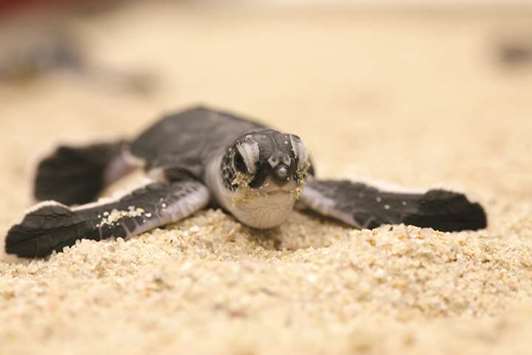Scrambling across large rocks on the edge of the beach, environmentalist Robert Lockyer is keeping a look out for any noticeable movement on the surface of water at Sham Wan on Hong Kong’s outlying Lamma Island. Lockyer, who is director of operations at Hong Kong’s Aqua meridian Conservation & Education Foundation, is awaiting for the arrival of green sea turtles.
A large object that looks like a ‘floating rock’ could be a green sea turtle, he says, even as the sun hangs low on the horizon. It’s still too early and too hot for them to come ashore.
“They are there. We’ve had divers and kayakers down there the last few weeks. The last four weeks now, they have been sighted in the bay,” he says.
The turtles have been slowly making their way back from as far as the Philippines, Indonesia and Vietnam to the beach where they were born 20 years ago with the help of the Earth’s magnetic field. For the first time in years, green sea turtles could nest in Sham Wan, the only regular nesting site left in Hong Kong for the species, according to Hong Kong’s Agriculture, Fisheries and Conservation Department. The last known successful nesting there occurred in 2012. Groups such as Aqua-meridian and the World Wildlife Foundation are using the momentum to renew calls for more environmental protections. While the dry sand of the 500-square-metre beach is protected and closed from June to October to encourage the turtles’ return, the waters of the bay, where turtles congregate and mate are not protected. Neither is the sand below the high-water mark. It’s these areas where the turtles face some of the greatest threats. Sea turtles can easily be impaled by items such as straws and forks while they make their way up the beach. In the water, their inability to retract their neck, unlike land turtles, means a collision with a boat or water ski which can be fatal.
They also have difficulty navigating with large amounts of trash or metal in the water, and can be disturbed by human activities. “What we’ve seen in recent years is there are so many recreational boats coming to Sham Wan. On public holidays, there can be more than 20 and up to 50 of them,” says lawmaker Ted Hui, who raised a motion at Hong Kong’s legislative council to protect the bay. “The turtles must be very much disturbed by the noise, the loudspeakers and the lights at night,” he says.
The motion, which passed unanimously in Hong Kong’s Legislative Council in May, asked for a no-anchor zone at the bay year-round as well as a ban on commercial and net fishing, and a ban on pedestrians on the beach and in the shallow waters. It is now up to the Agriculture, Fisheries and Conservation Department to come back with a proposal.
Environmental groups hopes to one day designate south Lamma as a ‘marine park’ due to its enormous aquatic biodiversity, although that goal may be further down the road. Lockyer and others are confident, however, that the government will be more inclined to act given the enormous popularity of sea turtles in Hong Kong.
A recent beach clean-up on Sham Wan drew 2,226 volunteers ahead of its closure for the summer - the largest group ever - and forced organisers to move it to another beach down the road. Lockyer attributed it to the popularity of the aquatic species. “Who doesn’t like turtles?” said Lockyer. “You can do a beach clean-up and you say you are going to pick up trash off the beach, it’s not really interesting. People get it, but it’s not vital,” he said.
“This year there were so many reports on social media about turtles sightings. People now know the turtles are out there so it was a call to arms, to say, come and clean this beach, save a turtle, or next week it may be too late.” – DPA

MENACE: Sea turtles can easily be impaled by items such as straws and forks while they make their way up the beach. In the water, their inability to retract their neck, unlike land turtles, means a collision with a boat or water ski which can be fatal.


